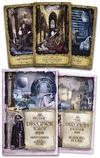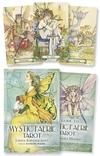Tarot: Play with Your Cards

Most people have heard that tarot decks were originally used to play a trick-taking card game called tarrochi. While the game is still played, particularly in Europe, tarot cards are more often used for other purposes, primarily doing readings. Some readers and some people who have readings approach the experience with a sense of play and drama, with a kind of "for entertainment only" style, the way one might read a newspaper horoscope or a fortune cookie fortune. Those of us who take our tarot a bit more seriously know that it is more than entertainment. We understand the wisdom, advice, and guidance we can receive from the cards. We treat our cards with care, ask our questions with a sincere heart, and interpret our readings with reverence. We carefully consider the symbols pictured, listen intently to our inner voice, and apply all we've learned about each card. We follow personal rules and find comfort in the ritual of shuffling, cutting, and laying the cards. We are very serious.
But there is something about cards that is closely associated with games. Beyond the natural connection of card games like rummy, Go Fish, and poker, board games also use cards, like Monopoly® or Cranium®. And of course there are collectable card games, such as Magic: The Gathering. In addition to the actual mechanics of game play, there is a more philosophical connection. Because cards are shuffled in most card games, there is always an element of chance and randomness. The players do not know exactly what tools they will receive, but whatever they are dealt, they have to play to the best of their ability in order to achieve their objective (which is usually to win the game). With a tarot reading, we are dealt a certain hand, only we call it a spread or a reading. We are given information and thus empowered, we are free to do what we wish.
In game play, players often have the opportunity to discard cards they don't and to draw new cards, although they often don't know what they will get. Because there are so many parallels between game play and tarot readings, maybe we can experiment, carry some more ideas forward from games to readings, just to see what happens. This idea intrigues me, because I confess, there are many times when I've laid out the cards and my hands immediately want to move things around, as if I were playing some sort of cosmic solitaire. And why shouldn't we? We do have the power to change our actions, our thoughts, and even outcomes. Do it within the context of a reading first, to see if you like the results. If not, try again until you come up with a favorable action plan.
To get you started, here are some ideas that I find both fun and useful. Some are just simple ways to things differently. Mostly, I advise ritualizing your reading technique (that is, shuffling, cutting, and laying out the cards in a similar way each time) in order to let your mind know that you are enter your reading zone. However, there are times when we are too comfortable and we get used to seeing things the same way, like if you use the same deck for years and you lay down a card and don't really "see" it anymore. Doing things differently will shake up the energy, kind of like a psychic alarm clock. To do this, simply do anything that you already do differently. If you riffle shuffle, then use the finger paint or overhand method. If you usually deal off the top, try spreading out the cards and select the number needed for the spread. Here is a method to get more information from a spread. After shuffling, use your non-dominant hand to divide the deck into the same number of piles needed for the spread you are doing. Then place each pile in position. Flip over the top card on each pile and interpret the spread as usual. If there are any cards that need more interpretation, consult the card on the very bottom of the pile to determine the underlying energy of the card in question. If the interpretation is not what you (or your client) would like, take the remaining cards in the pile, shuffle them, and select one as advice on how to turn that energy around.
This idea is from Donnaleigh de la Rose (host of the radio show Beyond Worlds and online at http://www.divinewhispers.net/). If there is an outcome that you (or your client) do not like, take the cards that precede the outcome and reverse them. That is, if they are upright, reverse them; if they are already reversed, turn them upright. Read the cards that you've changed as advice, as a way to shake up and change the energy and consequently the outcome. Donnaleigh says, "The cards work because it shows which ones are working against them if they receive an unwanted 'outcome.' If they release those cards (energies) that hold them back, they are now aware and in control of their outcome. It works particularly well for the 'challenge' position or 'what is holding you back.'"
And here is a final idea that can used either for a quick mini-reading or can be adapted as part of a larger reading. Think about your question. Think about what card represents the outcome you most desire. If you are doing this for a client who does not know tarot, let them describe their wish and you select a card to represent it. After deciding on the card, shuffle the deck (including the card you picked). Then, flip through the cards one by one until you reach the card you picked. Look at the two cards before it. The second card before it is a challenge or something that must be dealt with before the wish can manifest. The next (the card right before the card selected) is advice, what you should do to overcome the challenge or obstacle. The card following the selected card is just a little something that you might not have considered, usually an unforeseen consequence of the wish. Incorporate this into a larger reading if you the outcome is not to your liking. Find the four cards as described above. Remove any four cards from the spread and replace with the newly selected cards (in any way you wish) and interpret this new spread.

About Barbara Moore
Related Products



is subject to certain Terms and Conditions